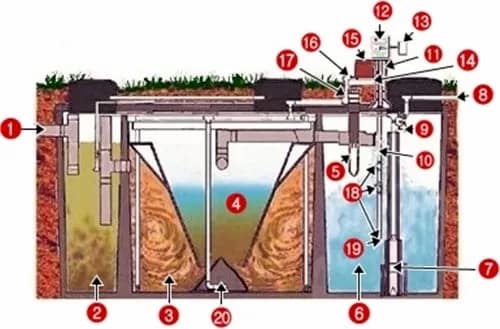How The Hoot Aerobic Septic Treatment System Works

Hoot BNR Septic Treatment Systems
Use the effluent from the Hoot BNR Aerobic Septic Treatment System to help water your landscaping. How does an aerobic septic treatment tank create such high-quality effluent?
The Hoot BNR Aerobic Septic Treatment System has four components: a pre-treatment tank, aeration chamber, a final clarifier, and a disinfection device.
Septic Pre-Treatment Tank
In addition to providing storage for non-biodegradables. The Hoot BNR pre-treatment tank also aids in the anaerobic decomposition of the influent.
Aeration Chamber
The aeration chamber, in addition to being the heart of the activated sewage treatment system. Allows pumping oxygen into the sewage using the Hoot BNR blower in such a way it intimately mixes the organics of the sewage with the bacterial populations of the aeration chamber. Because of the sewage movement in the aeration chamber, the activated sludge that has settled in the final clarifier is re-introduced into the aeration chamber to be reprocessed.
Final Clarifier and Septic Disinfection Device
The solids that settle in the clarifier produce a clear, odorless effluent and pass through the final disinfection device and into the pump tank for discharge at a later time.
- Inlet - Wastewater enters here.
- Pre-treatment Tank - Anaerobic digestion occurs. In addition to the storage of non-biodegradable material.
- Aeration Chamber - Introduce air into the sewage, in order to create the needed digestion.
- Clarifier - The still chamber where the solids settle, and the clear effluent rises.
- UV Light - Extra Disinfection (Optional)
- Pump Tank - Store treated and disinfected effluent prior to discharge.
- Effluent Pump - Discharge treated water from the Hoot.
- Discharge Line - Send effluent to the County approved dispersal method.
- Sampling Port - Service Personnel will use this to inspect the effluent quality.
- Probe - Monitors water levels within the tank
- Pump wire - From the pump to the control panel
- Hoot System Controller - Operates and regulates the control of the system.
- Power Line (30 AMP) - Independent breaker necessary for proper operation of the system.
- Troy Air Linear Air Blower - Long life, efficient linear blower which compresses atmospheric air and under pressure delivers it to the tank.
- Air Manifold - Delivers air from the line to the stones for diffusion into the sewage.
- Aeration line - Delivers air from the pump to the manifold.
- High Water Probe - Activate the pump and turn on the High-Water Alarm if needed.
- Low Water Probe - Switch the pump off.
- Probe Ground - Generates low water level alarm
- Aeration Stones - Air is finely diffused from the stone into the aeration chamber.
Recent Articles & Tips
-
Septic Repairs & Maintenance: 9 Early Warning Signs (and What We Do First)
A septic system is one of those home essentials that works quietly in the background until something goes wrong. The trouble is, many homeowners do not realize their system is failing until it is already too late. At Superior On-Site Solutions, we have seen it all, […]
-
Protecting Your Property: The Importance of Septic System Maintenance
Proper septic system maintenance is one of the most critical responsibilities for homeowners who rely on a private sewage system. Without regular care, your system can develop serious problems, including costly backups, system failure, and groundwater contamination. Whether you're new to septic ownership or simply want […]
